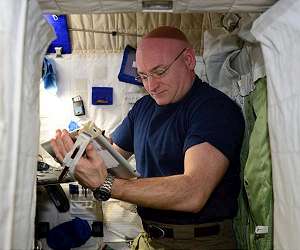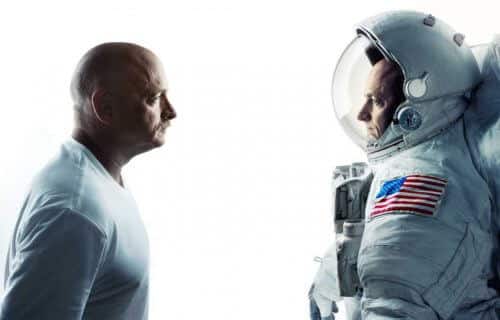First results of medical and genetic tests of the astronauts Kelly and Kononenko who spent a year in space and a comparison between Scott and his brother Mark were published at a conference of scientists working on human research at NASA

Researchers who examined twin astronauts Scott and Mark Kelly published their first findings this week. The annual researcher workshop of NASA's Manned Research Program held in Galveston Texas at the end of January provided an opportunity for researchers to publish early findings from studies conducted during the year-long stay of Scott Kelly and his Russian colleague Mikhail Kurinenko and after their return to Earth in March 2016. NASA notes that the studies are still ongoing .
Of these two, Scott Kelly is particularly interesting because he is part of an identical twin, and his brother Mark is also an astronaut. During the entire time that Scott Kelly was in space, his brother was on the ground, after retiring from NASA. The study showed differences in gene expression between the two brothers after Scott's 340 days in space. Tests done on the two before the flight, during and after the landing of Scott Kelly revealed changes in gene expression, DNA methylation and other biological markers that can be attributed to the time spent in space. These levels eventually got back on track after Scott Kelly's mission was over.
From the length of the twins' chromosomes to their gut bacteria, almost everyone who has tested them reports seeing differences," says Christopher Mason, a geneticist at Weill Cornell Medicine in New York. He and other scientists on the project reported their initial findings at a meeting of human space scientists with NASA at a conference held in Galveston, Texas on January 26. "The data is so fresh that some of it is still coming out of the garden paving machines," Mason said.
The challenge now is to understand how many of the observed changes are specifically due to the physical demands of space flight and how many of them are due to natural variations. Since the Kelly twins are only two people, it is not certain that the results can be generalized to other cases.
Still, the study includes the most detailed molecular profiling ever conducted of people involved in some of the most demanding physical environments. "The great importance of the study is to show that we can do the studies," says team member Andrew Feinberg, a geneticist at the Johns Hopkins University School of Medicine in Baltimore, Maryland. "I don't think people thought it would be so easy to do genomics studies on astronauts in space."

The annual researcher workshop of NASA's Manned Research Program held in Galveston Texas at the end of January provided an opportunity for researchers to publish early findings from studies conducted during the year-long stay of Scott Kelly and his Russian colleague Mikhail Kurinenko and after their return to Earth in March 2016. NASA notes that the studies are still ongoing .
Jacob Bloomberg presented results of the functional mission test, which measures the astronauts' ability to perform tasks they would be expected to do after landing on Mars while en route to zero gravity. The tests revealed that the team members encountered great difficulties in performing tasks that required postural control and muscle dexterity. However, in the other types of activities, no significant differences were seen between them and astronauts who stayed six months in space. However, further tests are required to confirm the findings.
Millard Rashka and Insa Kozlovskya who conducted the field study examining recovery times after landing discovered differences between the two in the rate of recovery even though they spent the same amount of time in space. These differences can be explained by the level of training and pre-flight experience. This finding highlights the need for better preparation for staying in zero gravity.
Michael Stenger examined the intraocular pressure (VIIP). Many astronauts have reported vision problems after returning to Earth. The cause is unknown. One member of the team had findings of VIIP including edema of the eye disc, and the other did not have these symptoms. It is possible that some parameters in the cardiovascular tests that were different between the two may be related to the results of the eye tests, but further research is needed.
Kritina Holden examined the change in the performance of the delicate tasks that might occur as a result of a long stay in zero gravity, especially the changes that might affect the ability of a future crew to accurately perform work with computer devices on a Mars landing. The study, conducted on an Apple iPad tablet computer, examined four types of fine motor tasks: pointing, dragging, shape tracking, and finger rotation. Preliminary results show that there was a decrease in accuracy and reaction time during the transition from zero gravity to gravity
Another finding, which is not certain if it is due to the extension of the stay or a smaller workload - the two slept an average of one hour more every night compared to astronauts on six-month missions - 7.1 hours compared to 6.1 hours.
Through further research by integrating the initial findings, in coordination with psychological tests and tests using various technologies, NASA and its partners will continue to ensure that astronauts will be able to carry out future space exploration missions safely, efficiently and effectively. The publication of the joint summary is planned for the rest of the year and will be accompanied by research articles.

3 תגובות
Oh great! In total, performing a fine motor test on an iPad... everyone sees what they want to see. It's really worth sending some of the businessmen of the religious establishment to space, and leave them there.
Wow, I didn't notice. The dome is a lighting game and the book is just a technical manual for operating the station.
He has a kippah on his head and is reading a Torah scroll or is it just me?